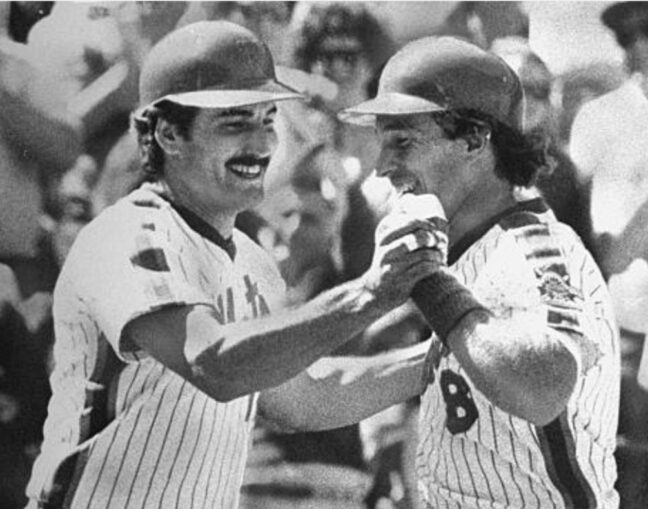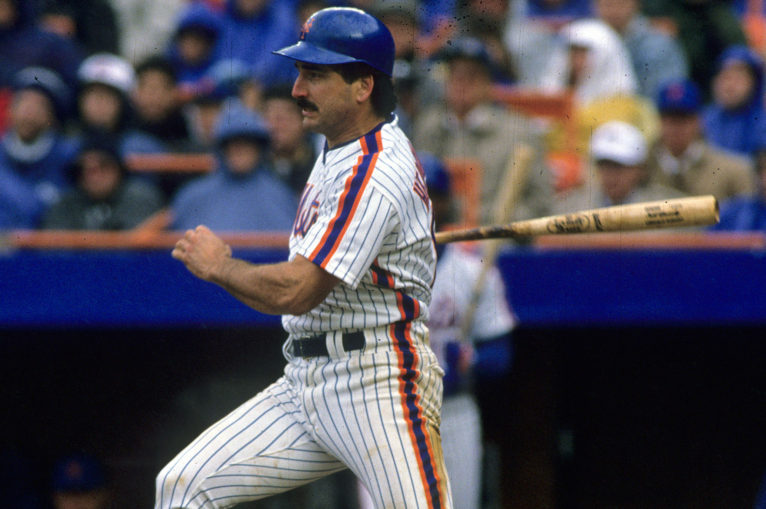
When something breaks pertaining to Mets history, such as the recent news that the club will be retiring Keith Hernandez‘s number, I’m happy to be a more “mature” Mets fan. When number 17 joins the other retired numbers high above left-center field at Citi Field, it will be a major milestone in Hernandez’s journey of nearly 40 years with the Mets.
I remember when I found out about the trade on June 15, 1983. I had decided not to try to play baseball in college (as Tom Seaver used to say, the other teams told me all I needed to know about my chances), so I was playing in a local league, generally populated by former high school players home for summer break.
After our game that night, I got in the car and put the Mets/Cubs game on the radio. The first thing I heard was Bob Murphy saying, “Well, Steve (LaMar), do you think there are flights from St. Louis to Montreal tomorrow?” I was puzzled. What was Murphy talking about? A few seconds later, he said that news of the trade just went on the scoreboard in right-center field, and the (small) crowd was roaring in approval. Wait, what? Was I hearing this correctly? The Mets had acquired Keith Hernandez? I was so excited that I missed who was going back to St. Louis. But really, it did not matter.
The Mets were to be off on Thursday, June 16, before opening a series in Montreal on Friday. Keith Hernandez, the 1979 co-MVP, was going to be in blue in orange. The guy who had the key hit in the decisive Game Seven of the 1982 World Series, the man who led the National League in batting average in 1979 at .344, was joining The New York Mets.
Sure, the Mets were having a bad year, as expected. Tom Seaver was back, and that was fun, but that was about it. The team had a record of 22-36, and was clearly going through a rebuild. Hernandez was an instant dose of credibility. We did not know how long he’d be in Queens, but one step at a time. The Mets had landed a superstar. It felt like the recent signing of Max Scherzer.
Hernandez had two hits in his first game as a Met, though the team lost 7-2 to the Expos. We had been hearing of the pipeline of talent. Darryl Strawberry was already up. Dwight Gooden and Ron Darling would be soon, as would Rick Aguilera and Lenny Dykstra to name a few. Instantly, there was a better feeling around the Mets.
As the 1983 season went along, the positive impact of Hernandez’s presence on the team could be seen. How about this play (note the pitcher)?:
Hernandez would go on to slash .306/.424/.434 as a Met in 1983. Then, reality set in. The team had seen his professionalism, and his impact on the younger players. They knew he would be a key piece in their quest to build a champion. But the Mets were going to have to pay him to keep him in Queens. Rusty Staub was a big factor in Keith’s decision to stay, as was Keith’s father, who told the first baseman that the better days with the Mets were on the horizon. The five-year contract (including a renegotiation of his 1984 salary) that Mets offered did not hurt either.
Going into the 1984 season, the Mets were emerging from the darkness of 1977-1983. While they fell short of the division title, their 90-72 record made a statement. Hernandez slashed .311/.409/.449 with 15 home runs and 94 RBIs. There was some concern over the blending of newly-acquired Gary Carter and Hernandez for the 1985 season, but the two worked together well, instrumental in the Mets’ 98-64 record (though they finished second in the division).
Keith’s on-field Mets story hit its apex in 1986. At 32 years of age, the San Francisco native put up a slash line of .310/.413/.446 with 13 home runs and 83 RBIs. His contributions that year were numerous. Two stand out to me as symbolic. This play shows his defensive prowess, which should (I hope) tip the scales in his favor some day for an election to Cooperstown.
And then there’s this one. Game Seven, 1986 World Series. The Mets were behind 3-0 in the bottom of the sixth inning, the bases were loaded, one out. I’m in the Loge behind third base, praying, begging, pleading for a hit. And please don’t let him hit it on the ground to an infielder. With my mind racing, I immediately thought of the 1982 World Series when Hernandez was up in a similar situation, also off a lefty, Bob McClure (this time it was Bruce Hurst). He got a hit that time, could he do us a solid and do it again? You bet he could. He’s Keith Hernandez.
The Mets still trailed, but you just knew. The man had gotten them on the board, and it was going to be okay. It wasn’t just the hit, it was who got the hit. With due respect to Strawberry, Carter, Ray Knight, and the rest of the squad, it was Keith’s team. Like a general leading the troops, he had cleared the path to victory.
Though he had solid seasons in 1987 and 1988, Hernandez was slowly tailing off, before having a sub-par 1989. After that year, his Mets’ tenure ended. Since then, it has been a joy having him in the television booth, most recently with Gary Cohen and Ron Darling. Keith’s candor and humor add elements to the broadcast that make it the best in the game. Here are two of my favorite Keith-isms.
“Gare, it’s getting colder in the mornings. I can’t go get the paper in the driveway in just my undies. I have to start wearing the robe.”
When Great American Ballpark in Cincinnati first opened, there was no way to show inside the bullpens on the game cameras. So, they showed the bullpens from monitors. Keith said, “This is ridiculous. It’s like looking at surveillance video from a 7-11.”
On July 9, 2022, number 17 will be retired. It’s overdue, and the number has been worn since Hernandez. None of that should take away from the fact that the Mets are doing the right thing, giving Keith his place in the ring of honor.
Here’s an MMO hat-tip to the one and only, Keith Hernandez.
















